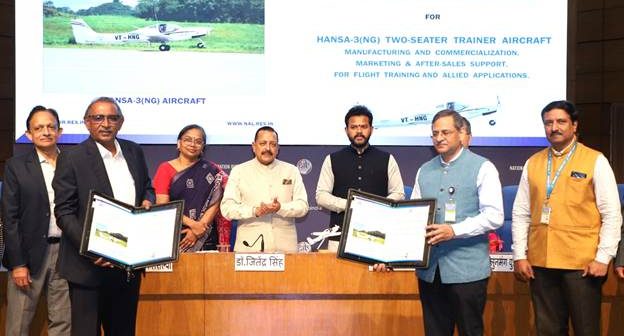In a landmark achievement, the Council of Scientific and Industrial Research (CSIR) unveiled the indigenously designed and developed HANSA-3(NG) trainer aircraft, signaling a transformative leap for India’s aviation industry. Officially launched by Dr. Jitendra Singh, Union Minister of Science and Technology, the aircraft aims to democratize pilot training, empower startups and small-scale industries, and position India as a global aviation hub.
The launch was marked by the formalization of the Transfer of Technology (ToT) agreement with Pioneer Clean Amps Pvt. Ltd., granting the private entity the license to manufacture, commercialize, and support the HANSA-3(NG) aircraft for pilot training and allied applications. This development represents a significant push for public-private collaboration, modeled on the success of India’s space economy initiatives, which are now being replicated in the aviation sector.
The HANSA-3(NG), a two-seater trainer aircraft, is designed to fulfill the training requirements of flying clubs for private and commercial pilot licenses. Equipped with advanced technological features, it boasts a fuel-efficient Rotax 912 iSc3 Sports engine, a modern digital glass cockpit system, electrically operated flaps, and a bubble canopy with a cabin width of 43 inches. The aircraft delivers exceptional performance with a cruising speed of 98 knots calibrated airspeed, a range of 620 nautical miles, and an endurance of 7 hours.
At the unveiling ceremony, Dr. Singh emphasized the socio-economic potential of the project, highlighting its ability to create significant employment opportunities through indigenization of aircraft manufacturing technologies. The initiative is expected to generate jobs for ITI and diploma holders in aircraft building and maintenance, further advancing India’s “Atmanirbhar Bharat” vision. The government’s focus on decentralizing and democratizing pilot training also seeks to make aviation education more affordable, addressing the aspirations of countless young Indians who previously abandoned dreams of becoming pilots due to financial constraints.
India’s aviation sector faces an increasing demand for trained pilots as the nation’s commercial aircraft fleet continues to expand. With over 1,700 aircraft on order and the current fleet exceeding 800, industry estimates project the need for 30,000 pilots over the next 15 to 20 years. Each narrow-body aircraft requires up to 20 pilots, while wide-body jets need up to 30. The production and widespread adoption of HANSA-3(NG) aims to address this demand by building a world-class flying training ecosystem.
The collaboration between CSIR and Pioneer Clean Amps Pvt. Ltd. involves the establishment of a manufacturing facility with an initial capacity to produce 36 aircraft annually, with plans to scale up to 72 units per year. Letters of Intent (LOIs) for over 110 aircraft have already been received from Flying Training Organizations (FTOs) nationwide, signifying robust market demand.
Highlighting the significance of HANSA-3(NG) for global competitiveness, Dr. Kalaiselvi, Secretary, Department of Scientific and Industrial Research (DSIR), praised CSIR’s commitment to developing indigenous technologies tailored to national needs. The aircraft’s successful demonstration at Aero India 2025 reinforced its potential for commercialization, ensuring it serves end-users such as FTOs while also capturing export opportunities.
The HANSA-3(NG) project aligns closely with India’s aspirations to become a leading aviation hub by 2030 and achieve the broader goal of Viksit Bharat by 2047. As the aviation sector embraces these advancements, the ripple effects extend to infrastructure development, small and medium-scale entrepreneurship, and innovation in airworthy component manufacturing.
Dr. Singh’s remarks underscored the importance of replicating the success of the space economy in the aviation industry to meet the growing demand for aircraft and pilot training infrastructure. The indigenous production of small aircraft not only boosts national pride but also lays the foundation for an aviation ecosystem capable of competing on the global stage.
The launch of the HANSA-3(NG) trainer aircraft is more than just a technological milestone—it represents a paradigm shift in the way India’s aviation industry operates. It empowers private enterprises, fosters innovation, and paves the way for inclusive economic growth, solidifying India’s position as a rising powerhouse in the aviation sector.





